Various Types of Twilight, the Lyrids Meteors Loom, and the Waning Morning Moon Passes Pretty Planets!
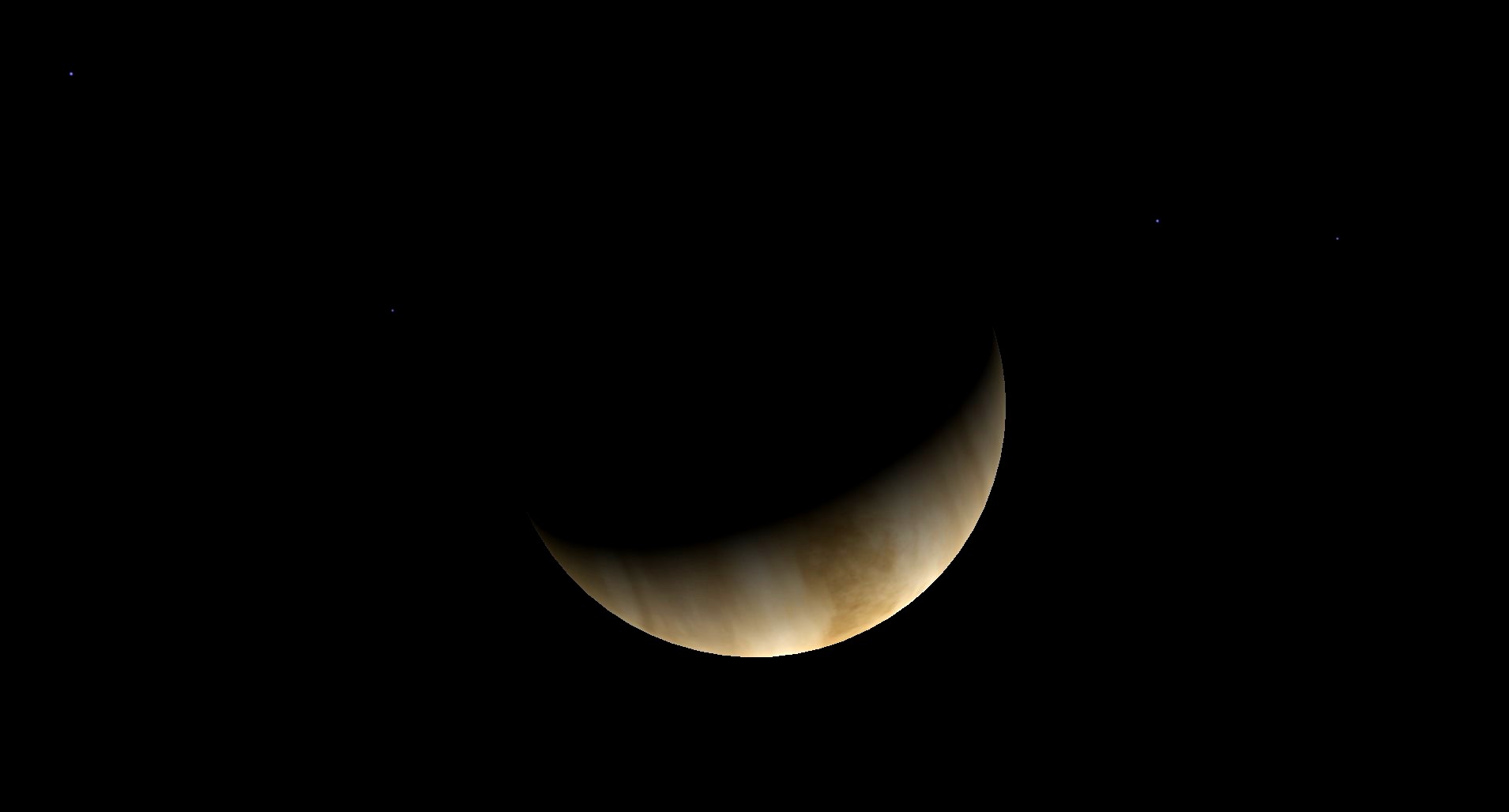
This simulated view of Venus shows the shape it will appear when viewed through a backyard telescope this month. Galileo was the first to note that Venus changed in apparent size and shape.
Hello, April Stargazers!
Here are your Astronomy Skylights for the week of April 12th, 2020 by Chris Vaughan. Feel free to send me your comments, questions, and suggested topics. You can also follow me on Twitter as @astrogeoguy! Unless otherwise noted, all times are expressed in Eastern Time. To receive Skylights by email, please click this MailChimp link.
I can bring my Digital Starlab portable inflatable planetarium to your school or other daytime or evening event, or we can meet up online. Contact me through AstroGeo.ca, and we’ll tour the Universe together!
The moon will be traversing the latter stages of its monthly orbit around Earth over the next two weeks, leaving night-time skies nice and dark for spring stargazing, and early Lyrids meteors. The moon will also make its monthly cruise past three bright pre-dawn planets. Bright Venus will show a lovely crescent shape. And I talk about twilight. Here are your Skylights!
Longer Daylight and Twilight Types
Casual skywatchers and astronomers are really starting to feel the effects of the later sunsets now. For people living at mid-northern latitudes the world over, the amount of daylight is increasing by almost three minutes with each passing day due to later sunsets and earlier sunrises. Conversely, in the Southern Hemisphere, the days are shortening as they head towards winter.
The varying lengths of day and night during the year are due to the fixed 23.5 degree tilt of the Earth’s axis of rotation and Earth’s motion around the sun. The north end of Earth’s rotation axis always* points towards a point in the sky called the North Celestial Pole (or NCP). The NCP’s position is 39 arc-minutes (or about two-thirds of a finger’s width) away from the medium-bright star we call Polaris, making that star helpful for aligning our telescope’s mounts. (*Over thousands of years, the Earth wobbles like a slowing top – causing its axis to trace out a large circle in the sky and making different stars take the role of Polaris.)
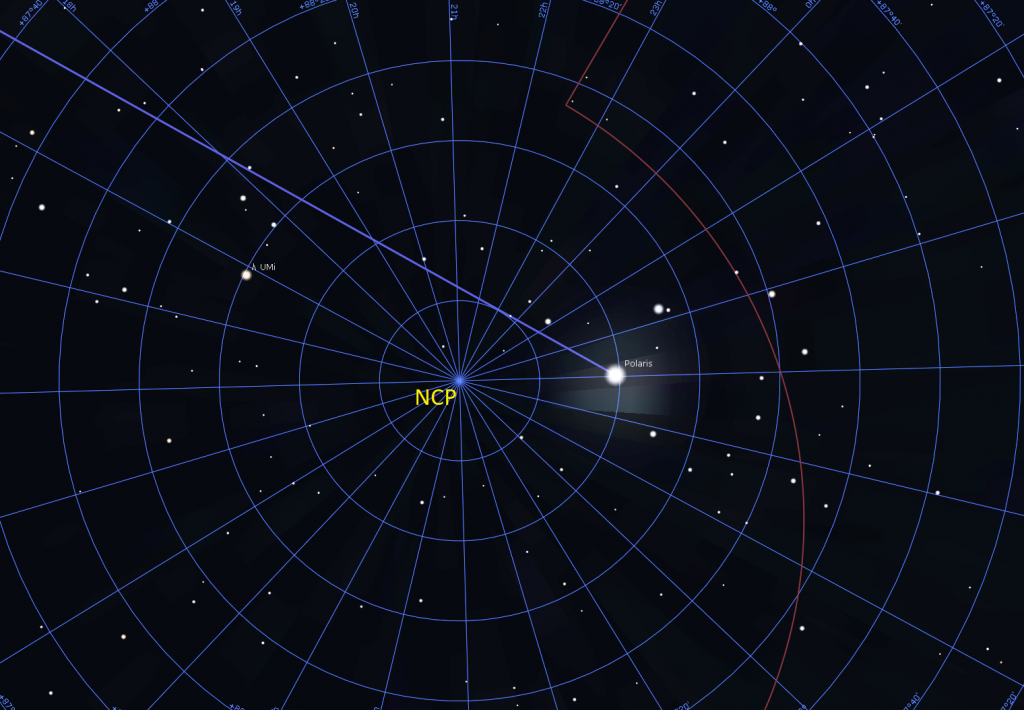
The South Celestial Pole (or SCP) isn’t located near a prominent star. The nearest visible star is Sigma (σ) Octans, which is also called Polaris Australis, Latin for “southern pole”. That star is near the limit of visibility for urban stargazers. It is offset from the SCP by more than 68 arc-minutes (a generous finger’s width) – not as helpful for setting up a telescope. Fortunately for southern astronomers, the SCP does sit within a little triangle of stars that are bright enough to see in binoculars and telescopes. I’ll post sky charts showing Earth’s two celestial poles here.

As Earth orbits around the sun, our northern axis spends time tilted towards the sun (especially at the June solstice), tilted away from the sun (especially at the December solstice), and not towards the sun at all (during the March and September equinoxes). Right now we’re a few weeks past the March equinox, when daylight amounts were increasing the fastest. At the upcoming June solstice, the daylight hours will peak in length and will also barely change from day-to-day. If you were to graph daylight hour lengths throughout the year, the curve would be a sine-wave – with the solstices at the peak and the trough, and the equinoxes on the maximum-slope spots.

This week, the sun will be setting at about 8 pm in your local time zone – but the sky won’t become fully dark until the end of Astronomical Twilight at about 9:45 pm local time.
When the sun is less than 6° below the horizon (after sunset or before sunrise) we experience Civil Twilight – the sky is still quite bright. When the sun is between 6° and 12° below the horizon (in evening or morning), the sky is still somewhat bright – a period we call Nautical Twilight. Astronomical Twilight is defined as the period of time when the sun is between 12° and 18° below the horizon – in the early evening and during pre-dawn hours. The sky is dark then – but not completely.
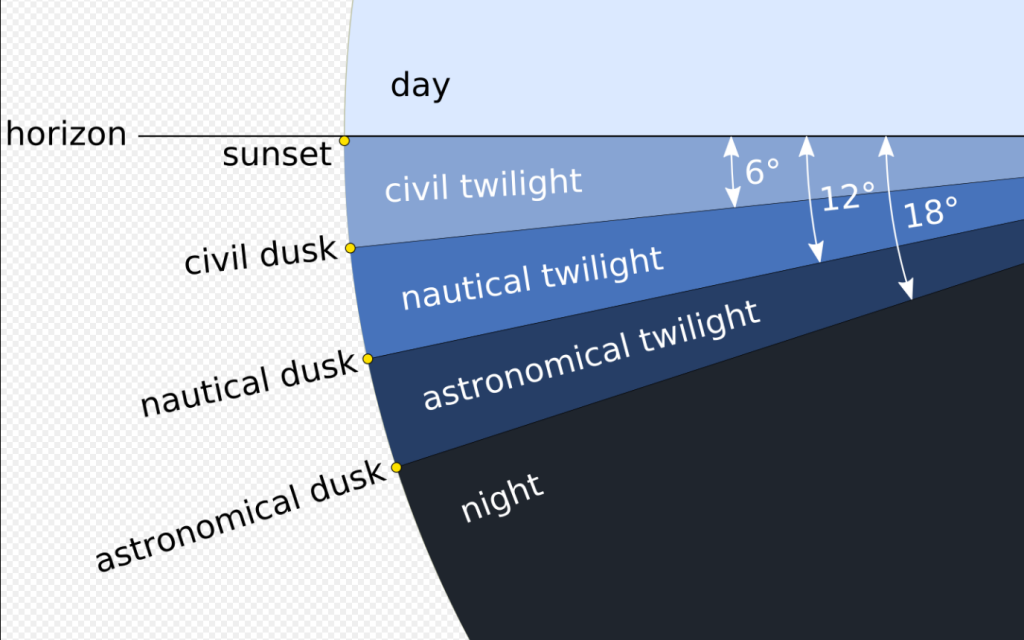
Each type of twilight lasts for about 24 minutes. That varies quite a bit, depending on the angle that the ecliptic makes with the horizon. Most of the time, that angle differs between morning and night – so morning and evening twilight durations aren’t equal. During the summertime, the sky is only truly dark for a few hours between the end of evening Astronomical Twilight and the beginning of morning Astronomical Twilight.
The Moon and Planets
The waning gibbous moon will rise in the east in the hours after midnight local time tonight (Sunday). Before dawn on Monday, look for the moon sitting just above the lid of the teapot-shaped asterism of Sagittarius (the Archer) and not far to the west of the trio of bright morning planets. The moon will remain visible during morning daylight all week long.
On Tuesday morning, the moon will begin its monthly visit with the planets Jupiter, Saturn, and Mars in the south-southeastern pre-dawn sky. The period between about 4:30 and 6 am in your local time zone on Tuesday, Wednesday, and Thursday will provide fantastic opportunities to see the moon with those three planets and take some photos!
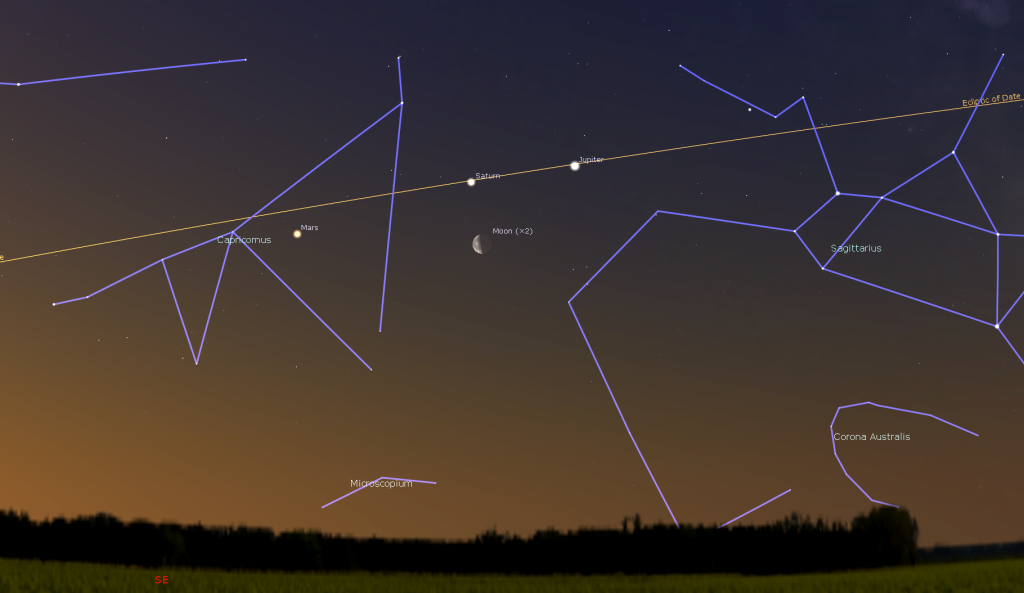
The three planets will be arranged in a line that spans about 15 degrees (or 1.5 outstretched fist diameters). Bright, white Jupiter will be on the right-hand, western end. Dimmer, yellowish Saturn will be positioned a palm’s width to Jupiter’s left (east), and reddish Mars will be lower and farther to the left (east) of Saturn. On Tuesday morning, the moon will sit a palm’s width to the right (or celestial west) of Jupiter. On Wednesday it will sit a few finger widths below (south of) Saturn. On Thursday the crescent moon will appear a few finger widths to the lower left (or southeast) of Mars. Those three planets will remain there after the moon passes on. For fun, watch Mars increase its separation from the other two planets every morning.
In the Eastern time zone, Jupiter’s Great Red Spot will be in view on Tuesday morning and Thursday morning. Jupiter’s moon Io will cast its small, round, black shadow on Jupiter on Monday morning, Ganymede’s shadow will be there on Wednesday morning, and Europa’s shadow will cross on Sunday morning.
Meanwhile, the moon will reach its last quarter phase on Tuesday at 22:56 GMT (or 6:56 pm EDT). At that time of its orbit, the moon is also positioned ahead of the Earth in our trip around the sun. About 3½ hours later, Earth will occupy that same location in space.
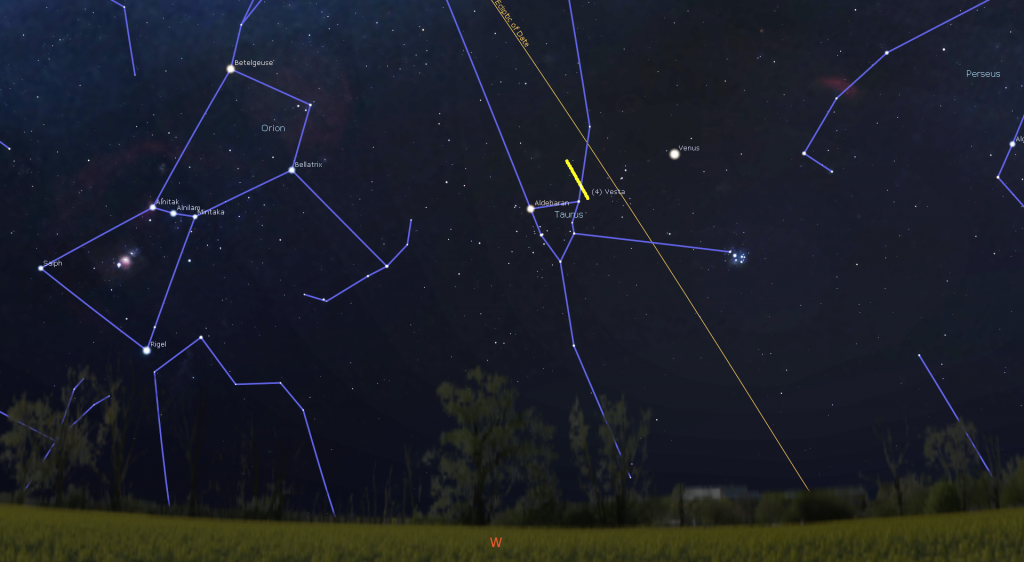
I took a look at Venus in my telescope a night or two ago. It’s now showing a very pretty crescent shape! It’s still increasing in brightness, too! On any clear night this week, Venus will pop out of the twilight sky at dusk, and then set in the west at about midnight in your local time zone. If you, too, want to see Venus’ less-than-fully-illuminated disk, aim your telescope at the planet as soon as you can pick it out of the darkening sky. In a twilit sky, Venus’ out-of-round shape will be more apparent. And, when Venus is higher in the sky you’ll be viewing the planet more clearly – through less of Earth’s distorting atmosphere.
The main belt asteroid Vesta has been accompanying Venus in the western evening sky recently. Tonight (Sunday), Vesta will pass quite close to the right (or celestial north) of a medium-bright star named Ain, or Epsilon (ε) Tauri. The asteroid will require binoculars or a telescope to see it. I’ll post a sky chart of the arrangement here. (Don’t forget that your telescope will likely flip the view around.)
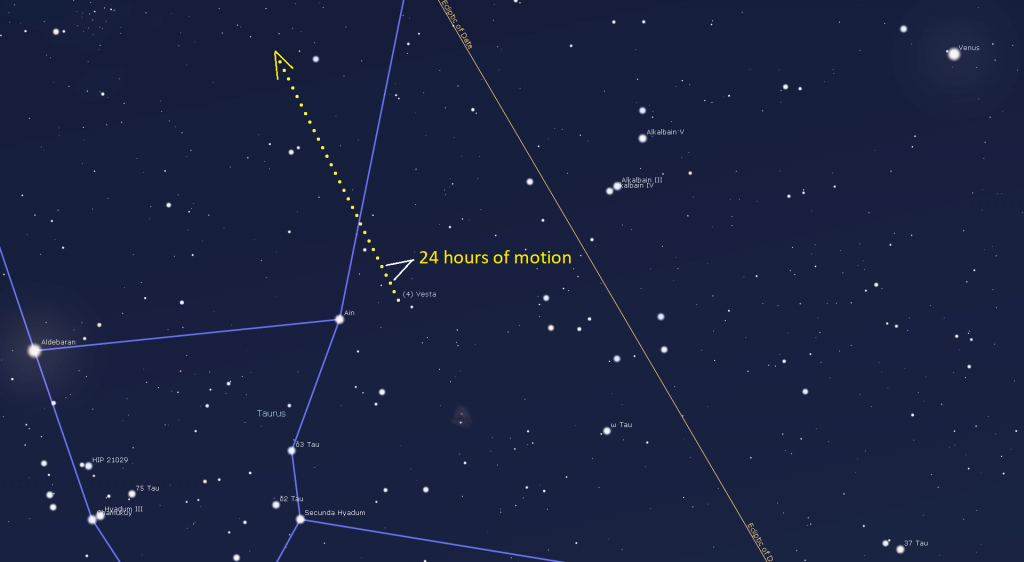
I’ll post sky charts for all the observable planets here.
Lyrids Meteor Shower
The annual Lyrids meteor shower, derived from particles dropped by comet C/1861 G1 (Thatcher), runs from April 16 to 25 every year and peaks before dawn on Wednesday, April 22, worldwide – so you can start to keep an eye out for some as the shower ramps up later this week. The Lyrids shower can deliver up to 18 meteors per hour, with occasional fireballs. True Lyrids will appear to be travelling away from a point in space (the shower’s radiant) near the bright star Vega, which will be high in the eastern sky before dawn. This year, the moon will be close to the sun on the peak date, leaving skies nice and dark for meteor-watching. I’ll share some tips for seeing them next week.
I’m LiveStreaming Astronomy for Families
Insider’s Guide to the Galaxy, our twice-weekly free, one-hour, live daytime astronomy broadcasts geared towards families in partnership with the Royal Astronomical Society of Canada, will continue on April 21. I’m taking this week off to plan future sessions. Instead, two other RASC members will be streaming about astrophotography on Tuesday and Thursday at 3:30 pm EDT, co-hosted by the terrific Jenna Hinds, Youth Coordinator at RASC.
During our very first Insider’s Guide stream we learned how to install and set up Stellarium – a fantastic and 100% free astronomy program that I use to prepare my Skylights every week. We ended the session by sharing a set of Astro-Scavenger Hunt questions that you can find here. Re-watch that video here, and then tackle the scavenger hunt. On Thursday, we revealed the scavenger hunt answers in a fun and informative way, and then we talked about viewing the night sky – with your unaided eyes, binoculars, or telescopes. That video is here.
The April 7 session, which you can watch here, was focused on the moon and viewer questions, complete with a new set of questions for Mission Two. The questions are listed here.
Feel free to send us ideas for future sessions. More information, the schedule, and the Zoom link to sign up are all here. If we reach Zoom’s capacity of 500 viewers, you can watch the sessions on the RASC’s YouTube channel in real time, or later on.
I look forward to “seeing” you online soon!
Public Astro-Themed Events
Due to the COVID-19 virus, public star parties and lectures have been cancelled or postponed for the moment. Here are some Internet-based astro-themed activities.
On Monday evening, April 13 at 7 pm EDT, Apollo expert and RASC Mississauga President, Randy Atwood will deliver an online talk about Apollo 13. For more information, and to register for the Zoom session, click here.
On Wednesday evening, April 15 at 7:30 pm EDT, the RASC Toronto Centre will live stream their monthly Speakers Night meeting. This meeting will feature Professor Michael De Robertis, Dept. of Physics & Astronomy, York University speaking on the topic Intelligent Life Beyond Earth? Everyone is invited to watch the presentation live on the RASC Toronto Centre YouTube channel. Details are here. The RASC Toronto Centre has an archive of their past meetings and guest lectures on their YouTube Channel here.
Many astronomers are running broadcasts of the views through cameras attached to their telescopes while they describe the item and take questions. A search for the terms “star party” on YouTube and FaceBook should let you find live or pre-recorded sessions.
The Canadian organization Discover the Universe is offering daily astronomy broadcasts for students called Astro at Home. Their website is here, and their YouTube channel is here.
On many evenings, the University of Toronto’s Dunlap Institute is delivering live broadcasts called Cosmos from Your Couch. The streams can be watched live, or later on their YouTube channel here.
The Perimeter Institute in Waterloo, Ontario has a library of videos from their past public lectures. Their Lectures on Demand page is here.
Space Station Flyovers
There are no visible ISS (or International Space Station) flyovers for the GTA this week.
Keep looking up, and enjoy the sky when you do. I love questions and requests. Send me some!